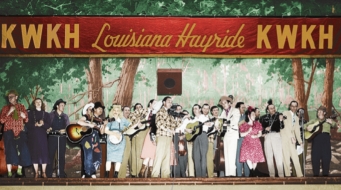Legendary Musical Roots

‘Cradle of the Stars, KWKH & The Louisiana Hayride,” a new history of the variety show broadcast that put Shreveport on the map, has arrived. It is a beautifully designed, large-format book with a ton of photos.
Stepping into the pages of author/designer Joey Kent’s book, some 15 years in the making, he says, is like walking into a big-city museum. The prose is butter smooth, and the photos seem never to end.
Kent’s book is the answer to the short coverage given Shreveport in the Ken Burns series, “Country Music.”
In some 200 pages, it offers surprises (the Hayride lasted that long!) and affirmations (yes, Jerry Lee Lewis played the Hayride in 1957).
 All said and done, the book quietly asks a vexing question: Why hasn’t anyone in Shreveport produced a show or even a visitor center that effectively picks up on the thread of the Hayride?
All said and done, the book quietly asks a vexing question: Why hasn’t anyone in Shreveport produced a show or even a visitor center that effectively picks up on the thread of the Hayride?
Many have tried, including Kent’s dad, David Kent. From 1974 to 1987, he produced a follow-up show in Bossier City. Called “Hayride, USA,” then the “Louisiana Hayride,” it included a popular restaurant, the Hayride Kitchen. Also attempting to bring it back was producer Bill Starnes. The determined team of Maggie Lewis and Alton Warwick (singersongwriter Maggie Warwick died at age 80 in March 2019, after a brief illness) produced well-researched media and facility plans for the Hayride Village. It would have included studios, restaurant and related offices. That vision did not come to fruition.
This book is a snapshot of a world that is gone and not to return unless it is reimagined by a new generation.
The massive volume of advertisements used in telling the Hayride story is a reminder that there is a back story. There are a thousand publicity photos. There are few of the informal shots that are common today.
But candid moments are there, too. Kent’s coverage of the 1948 arrival of Hank Williams includes salty incidents such as the conception of Hank Williams Jr. in the back seat of Hank’s car parked behind the Municipal Auditorium. And the gritty fact that Murrell Stansell had to ante $50 to help pay for the baby’s delivery at Schumpert some nine months later.
After a three-year stint in Nashville at the hallowed Opry, Williams had to return to the Hayride. His drinking and drug addiction dogged his performances in Nashville. Audrey divorced him. The Opry fired him. Nonetheless, the Hayride audience adored him.
Within a few months, he succumbed to the depredations of drugs and alcohol while being driven to a concert. He was age 30.
Readers can luxuriate over the big names that powered the Hayride between Hank and Elvis. Kent’s book waxes over singer Webb Pierce (West Monroe, La.), “the ‘Wondering’ Boy.”
Slim Whitman may have influenced Elvis in a couple of ways, says Kent (it was hair and shoes). The singer, who took a job as a postman in Queensborough during a career lull, is seen as the next star to rise at the “Cradle of Stars.”
Faron Young was a Fair Park HS grad and briefly a Centenary College student on his way to becoming a Hayride star. Johnny Horton and Jim Reeves are honored in photos and essays.
Eventually, all Hayride tales turn to Elvis. One story that may puzzle some readers is that in the beginning radio listeners in Shreveport are said to have thought Elvis was a black singer. The 1950s saw local radio announcers trying to imitate black voices to evoke the excitement and authenticity of folk culture. Indeed, Elvis had absorbed tunes, attitude and vocal styling from listening to singers like Arthur “Big Boy” Crudup.
The shaking leg that inflamed his fangirls seems to have been a naturally nervous response to the stage, says Frank Page.
The excitement engendered by Elvis in the mid-1950s created a wave of new music. It was rockin’ country, later termed rockabilly. It was a cool new drink distilled at the Hayride. Johnny Cash sang “Ballad of a Teenage Queen.” George Jones tried country bop. So did Johnny Horton. A Texan named Bob Luman sang the new sound the best, explains Kent.
Luman
took it from the Hayride to Hollywood. “Horace Logan, who had never
gotten over letting Elvis slip through his fingers,” left the Hayride,
quit KWKH and went with Luman and David Houston to try the movie
business (“Carnival Rock,” 1957). The Hayride sent tendrils of music in
virtually every direction.
Kent’s history of the Hayride is important to Shreveporters. It says, “Look at what you had. Be proud.” It also implies, “You might do something like this again.” To the rest of the world, the Kent book will help balance the scales between the Opry and the Hayride. Musicians and historians have noted the way that the Opry dominates the literature. The recent coverage in the Burns documentary is an example of it.
With the color and heft of this book, Joey Kent has sent a message to the world of music lovers. The story is that there was a world of value in the long life of the Hayride.

